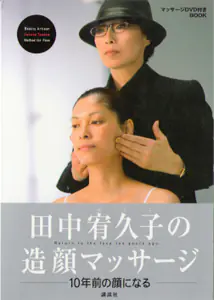
The name of this massage as “ASAHI Massage” is widely “promoted” on the Internet. The true name of this Japanese massage is ZOGAN-massage (Face Creation). In Japan, this massage technique has been passed down from generation to generation since ancient times. She owes her return to life to a cosmetologist Hiroshi Hisashi, who was introduced to this technique by her grandmother.
This technique is also called “two-finger” massage (because it is performed mainly with two fingers - the index and middle or middle and ring fingers), or it is called Y-method.
Stylist Yukuko Tanaka (Youkuko Tanaka - 田中宥久子 - 1946- — 19.03.2013) - you see a photo of this 62-year-old Japanese woman - she described the massage in the book “Special Facial Massage - Back 10 Years”前の顔になる) .
In Japan, Mrs. Tanaka herself and her methods are extremely popular. Her book “Facial Massage” (and this is ours, Asahi!) topped the “Top 10 Books” in Japan in 2006. Another of her books, Inspirational Exercises, took second place. To complete the comparison, Joanna Rowling's book about Harry Potter came in third place.
The Russian-speaking population was able to get acquainted with this massage-gymnastics thanks to Laina Butter. Laine found it on the Internet and came up with a name for it - “Asahi Massage” (which means “Morning Sun” in Japanese). After all, this massage is really associated with something fresh and sunny. The name of the creator of the massage, and more detailed information about this massage became known a little later, thanks to the “investigation” of another girl passionate about facial beauty - Aigul.
This is a very effective technique, after which the face is smoothed out after the second session. The massage has an effect on the bones (and therefore it is osteopathic - it returns the bones of the skull to their ideal position). It also affects the connective tissue and most of the deep muscles of the face, revitalizes them, and awakens the energy of the body, opens and cleanses the most important channels. The structure of connective tissue after massage significantly improves, and the skin looks 7 years younger. The face gains youth.

If a stranger watches some of the techniques, he may be frightened by the sight and may think that the massage will create new wrinkles. And he will be wrong. When the bones and deep muscles of the face come to life (in Slavic healing practices this is called “editing”), the face returns to life. The skin actually appreciates being stretched. After all, leather is just a stocking. The real decoration can be the leg, and the stocking fits on it as the leg allows. Same with the face. The facial muscles are a “leg,” and the skin is just a “stocking.” Over time, not only the skin, but also the muscles become sluggish. This is why wrinkles cannot be removed with “light, delicate” movements. But they happily go away when we competently influence the deeper tissues. We often admire oriental “ageless” faces. But oriental massages, unlike salon cosmetic procedures in Europe, work on the face, giving it real, vital stress. And oriental masters suggest their clients continue the daily exercise at home, intensively rewarding themselves with strong slaps in the face to improve blood circulation in the face.
“Dzogan” is a painless technique, which, however, involves the targeted use of reasonable force. Asahi self-massage must be performed delicately and carefully. Particularly high caution is required in the area of lymph nodes. Where there are no lymph nodes (see diagram), we work confidently and intensively.
This multifunctional massage-gymnastics is designed in such a way that it affects both the superficial and deep muscles of the face. The tone of the skin and muscles increases (hence the tightening effect). Lymphatic drainage improves the appearance of the face.
Before starting the massage, the skin of the face must be cleansed. It is necessary. After all, it is necessary to free the ducts through which the lymph flows.
CONTRAINDICATIONS for massage:
– diseases of the lymphatic system,
-ENT diseases (especially inflamed tonsils),
– facial skin diseases.
-You shouldn’t do a massage if you feel sick (even with a runny nose), because inflammation spreads with the lymph flow.
-Take care of yourself during your period: For some, the massage will be great, for others the bleeding may increase. There is no ban on massage during menstruation, but watch yourself.
-Fatigue, depending on its nature, is also a contraindication for some, while others can easily relieve it with a massage. The main criteria here are your opinion and your well-being.
– Massage relieves the face of swelling, so a thin face becomes even thinner. People with a small amount of fat on the face (with sunken cheeks) need to perform the massage very carefully and stop for a long time as soon as the effect of facial slimming occurs.
In the original, a special composition of cosmetic cream with cotton was developed for massage. But he will have to be discharged from Japan. The massage works just as well with makeup remover milk and foam. Your hands glide perfectly over the oatmeal milk (to do this, you need to put rolled oatmeal flakes in a nylon stocking, tie it, wet it well, and during the massage simply squeeze the milk into a cup or into your palm.
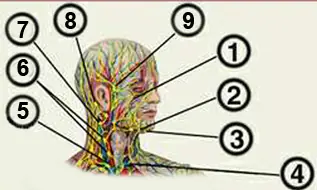
According to the descriptions of Yukuko Tanaka, the massage should be performed in a standing or sitting position. During the entire massage, you must maintain ideal posture. The instructions do not allow your head to rest against the wall behind you or on the headrest of a chair. But the experience of pioneers from Europe allows us to make some concessions. For example, it turned out that massage is no less (and maybe more) effective if performed while lying down. In this position, the muscles seem to spread across the face, the deep tissues relax and become obedient to correction. In general, the choice of position for the massage is up to you.
Now let's move on to the details. The first is lymphatic drainage.
Pay attention to the diagram of the lymph nodes of the face and neck. You need to massage the lymphatic system carefully and delicately, calculating the effort, applying only slight pressure along the entire path of the lymph flow. Under no circumstances should you put pressure on the lymph nodes themselves. This is perhaps the fundamental rule of Asahi massage or Dzogan massage. 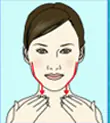
Now we will teach you the finishing move that ends all exercises except one. There is not a single unnecessary movement in the massage, they all work on the corresponding zones, and end with a technique in which the movement of the hands is eliminated to point 9 – parotid lymph nodes, located approximately in the area between the tragus of the ear and the temple. Having reached point 9, fix it with your fingers for 1-2 seconds. Then continue the SOFT movement - go along the sides of the contour of the face, past the jaw joint (WITHOUT PRESSURE on it!), Pay attention point 6 - deep cervical lymph nodes, (it is located approximately 2 cm under the lower jaw), fixing your fingers on this point for 1-2 seconds. Once you stop, slowly work your way down the sides of your neck. Finish moving in the area lymph node 5, located in the jugular trunk, almost at the inner edge of the clavicles and jugular cavity. Here again fix the point of the lymph node with your fingers. In the figure, arrows show the route for completing the reception.
Let's move on to ZOGAN-massage or Asahi self-massage exercises.
Exercise 1. SMOOTHING THE FOREHEAD.
Repeat the exercise 3 times.
Exercise 2. ENLARGEMENT OF THE EYES. ELIMINATION OF SWELLING. 
Note: The direction of some massage lines, in this, as in most other oriental massages, differs from the classic lines recommended by European cosmetologists which, in part, are more related to the convenience of the cosmetologists themselves than to the physiological characteristics of the face.
In Eastern (and Slavic) massages, massage lines around the eyes go along the orbicularis oculi muscle, but on the upper eyelid, just like Europeans, from the inner corner of the eye to the outer, and on the lower (!) - not from the outer corner to inner, and again from the inner to the outer corner of the eye.
The exercise consists of two stages: working with the upper eyelid, and separately with the lower one.
Raise your hands to your face, spread your elbows to the sides parallel to the floor. Place the pads of your middle fingers at the outer corners of the eyes (for the Japanese this is the “tail of the fish”) and lightly, without pressure, move them to the inner corners of the eyes (to the “heads of the fish”). Now stop near the inner corners of the eye (famous beauty spots). Now increase the pressure a little and draw a hemisphere along the radius along the upper orbital bone to the outer corners of the eyes and fix your fingers at the temples for 3 seconds. Again, loosen the pressure and barely touching the skin, “complete” the circle under the lower eyelid again to the inner corners of the eyes, return to the beauty points.
And now - attention! Here we change direction and, with a little more pressure, return along the same route, along the LOWER orbital bone back, from the inner corner to the outer. Hold the fish's tail for 3 seconds, applying gentle pressure with your index and middle fingers.
After this, continue moving your hands to your temples. Having fixed the points at the temples for 3 seconds, Now without any pressure at all, we bring the movement to the lymph node at the tragus of the ear, from there we perform final move, described above.
Repeat the exercise 3 times.
Exercise 3. MOUTH. CHIN. LIFTING THE CORNERS OF THE LIPS. 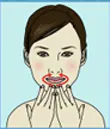
Place the middle and ring fingers of both hands into the hollow in the center of your chin. Hold the point with pressure with your fingers for 3 seconds. Continuing the pressure, move your fingers around your lips and bring your fingers together in the center above your upper lip. Press your fingers again for 3 seconds, lifting the nasal septum with your ring fingers. After 3 seconds, lift your fingers from your face, without performing the finishing move, transfer them again to the hollow in the center of the chin.
This is the only exercise that does not end with a finishing move.
Repeat the exercise 3 times. Without the finishing move, proceed to exercise 4.
Exercise 4. SMOOTHING CHEEKS, NASOLABIAL FOLDS AND LIPS. 
Move your fingers to the upper depressions near the wings of the nose (into the “dog fossa”) and make 5 arched movements down and up on both sides of the wings of the nose. Now, without pressing, without removing your fingers from the skin, smoothly move your middle and ring fingers to the upper part of the bridge of the nose and rub the bridge of the nose three times from the bridge of the nose to the naso-cheek fold.
Having finished the exercise, press your hands towards the tragus of your ears and perform the finishing move.
Repeat the exercise 3 times.
Exercise 5. CORNERS OF THE MOUTH, CHEEKS, CHEEKHOUSES. LIFTING THE UPPER JAW. 
Press the three middle fingers of your hands into the hollow in the center of the chin, as in exercise 3. Using fairly strong pressure on the skin and muscles, circle your fingers around your lips and continue moving forcefully towards your eyes.
>Hold for 3 seconds near the eyes, continuing to apply pressure to the skin. Then gently spread your fingers towards your temples and perform the finishing move.
Repeat the exercise 3 times.
After performing the exercise correctly, you should feel that your upper jaw and cheek bones have lifted upward, and your cheeks have plumped and plumped up.
Exercise 6. LIFTING THE LOWER FACE AND CHEEKS.
Repeat the exercise for one side of the face 3 times in a row.
Do the same steps three times for the other side of the face.
Exercise 7. STRENGTHENING THE MIDDLE FACE AND CHEEKS.
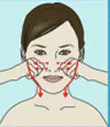
This exercise must be performed after the previous one - in exactly this sequence.
Spread your elbows out to the sides and place your fingers flat on your cheeks horizontally. Another option for performing the exercise is shown in the picture on the left: form your hands into a fist and work with the outside of your index fingers. Squeezing your nostrils with your fingers, forcefully spread your fingers towards your temples, and perform the finishing move.
Repeat the exercise 3 times.
Exercise 8. FACE LIFT

.Place your elbows and palms together in front of your chest. Open your hands with your palms facing up. Place your open palms in front of your lips. The “chairs” of the palms are in the center of the chin. With pressure, lift your palms to your nostrils and “put” your cheeks in your palms. Hold your cheeks with pressure for 3 seconds. Lower your face down a little and “draw” a smile with your palms, extending it to the tragus of your ears. Now raise your palms to your temples. From the temples perform the finishing move.
Repeat the exercise 3 times.
Exercise 9. REMOVING THE SECOND CHIN.
Repeat the exercise for each side 3 times.
Exercise 10. REMOVING NASOLABIAL FOLDS. 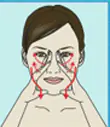
Place the thumbs of both hands under the center of your chin. Use your remaining fingers to clasp your nose. “Hide” your nose between your palms. The position of the hands now resembles a “prayer pose.”
Forcefully spread your palms towards the tragus of your ears and temples, as if “squeezing” your face. Fix your hands here for 3 seconds. Then perform the finishing move.
Repeat the exercise 3 times.
Exercise 11. ELIMINATE WRINKLES ON THE FOREHEAD. 
Using the fingers of one hand, in a zigzag motion, gently smooth the forehead from right to left, then from left to right, then again from right to left. Do not try to move the skin. After this, put your other hand to your face. After this, repeat exercise 1 once and finishing move.
Gymnastics massage Yukuko Tanaka
found and prepared illustrations
LINE BUTTER-PAVLOVSKAYA
The description of the exercises was TATYANA CHEKALOVA
You can discuss ASAHI massage ON THE FORUM

Lymph nodes are one of the important organs of the human immune system. Among them, the lymph nodes on the face play an important role. There are nodes on the face, the medical name of which is:
- infraorbital or maxillary - they are scattered throughout the infraorbital region located between the nose and cheek (the section of the groove up to the zygomatic arch);
- cheek - can be from one to several located on the muscle opposite the corner of the mouth;
- mandibular - mental (located on the chin) and submandibular, located on the upper surface of the lower jaw in contact with the maxillary external artery, as well as with the facial anterior vein.
Through their afferent vessels, the fluid washes the eyelids, skin, conjunctiva, inner surface of the nose, cheeks, and passes into the glands called submandibular glands. In addition, there are several cheek nodes, near the ears (they are called parotid). The mandibles are the most common cause of concern.
There are two groups of parotid glands. Smaller glands are sometimes found in the subcutaneous cell. Lymph from their afferent vessels flows through the eyelids, root of the nose, frontotemporal region, tympanic cavity, external auditory meatus, posterior parts of the palate and nasal cavity.
In the classification of lymph nodes, there is such a concept as the sides of the face, which, in addition to the infraorbital and maxillary glands already described above, includes supramascular and articular glands. Their function is to collect lymph from the cheeks, conjunctiva, mucous membranes of the nose and eyelids.
You can come across this group name: submicrobial. These are 3-6 submandibular glands. They can be found in the submandibular triangle, below the lower jaw. They receive fluid from the upper lip, the lateral parts of the lower lip, cheeks, vessels of the nose, gums and tongue.
How are the lymph nodes located?
The location of the lymph nodes is rational. Their placement throughout the human body is such as to act as a barrier to bacteria, viruses, malignant cells and any other foreign impurities that enter the body and are captured by the lymph. Lymph flows in one direction: from a person’s feet to the head, and then flows by gravity down to the feet. Along the way, the liquid flowing through the capillaries and vessels is collected in larger ducts and flows to the center, where it flows into the veins. The glands are placed in such a way as to filter the lymph entering the blood vessels and internal organs.
Location of lymph nodes on the face
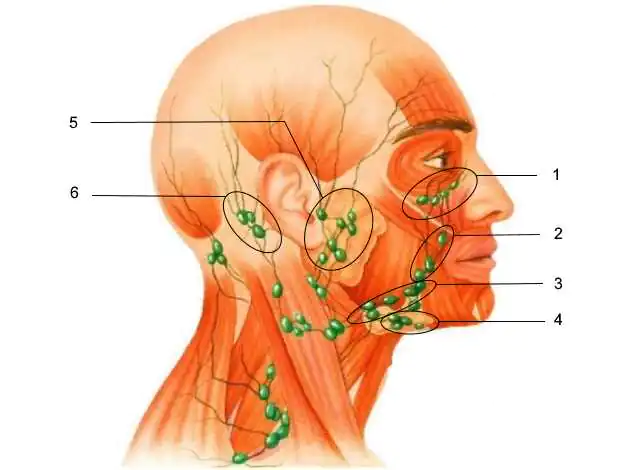
Places where the lymph nodes are located: the inner corner of the eye, the infraorbital foramen, the upper part of the “nasolabial” groove, the nasal openings, the tissue above the middle of the cheek muscle, near the ear (this is the line connecting the corner of the mouth with the auricle).
Doctors consider the buccal and mandibular or supramillary glands to be unstable. They are located in the tissue near the point of attachment of the masticatory muscle, outside the lower jaw. They come from 1 to 2.
Near the ears you can find superficially located facial nodes located under the parotid-masticatory fascia, in front of the external auditory canal.
In addition, there are from one to two deep nodes between the lobules of the parotid glands, at the level of the earlobes; several may be located behind the ears, behind the angle of the lower jaw, they are covered by the salivary gland located near the ear. “Posterior” nodes are located near the mastoid process.
Below the angle of the jaw, there are submandibular lymph nodes in the bed of the salivary gland located below the jaw, but do not lie in its capsule. The nodes are located at the back, front and middle.
Several mental nodes are located in the triangle between the anterior bellies of the “digastric” hyoid bone.
Located between the “maxilloglossus” and “genioglossus” muscles in its thickness.
The buccal, mandibular, “submandibular” and chin nodes are characterized by the fact that, together with the lymph entering them from the jaws, teeth, salivary glands, paranasal sinuses, mucous membrane, and oral cavity, they become infected.
Problems related to lymph nodes
Since they are filters due to antibodies that fight infection in the human body, they react to any infection in the body. The lymph nodes swell, become red, or become hard. Such glands usually become enlarged, painful, and when pressure is applied to them, the pain intensifies. Pus accumulates in the swollen gland, the abscess may burst and the pus will then spread across the cheek and other nearby area. In this case, the patient’s body temperature may rise, headaches, and malaise. Enlarged lymph nodes on the face (cheekbones, cheeks, chin and other places) are dangerous for people; serious complications such as encephalitis and meningitis can develop.
The consequences of swelling of the lymph nodes, which are located deep in the body, may differ from the consequences that accompany swelling of the nodes under the skin. A blockage in the lymph flow of a swollen deep node can lead to consequences such as swollen limbs, swollen lymph nodes in the lungs, and cause a chronic cough
First of all, the glands respond to infection of a nearby organ. For example, if the infection is associated with the ears, then the reaction will be either the superficial ear nodes or the deep glands behind the ear. Symptoms of swollen facial nodes may include: swollen cheeks, pain when chewing.
Treatment for a swollen lymph node in the cheek
Treatment of swollen cheeks should be aimed at restoring the normal state of the lymph nodes. There are many conditions that cause an abnormally round face. Among them:
- A dental abscess is an infection that causes throbbing pain, facial swelling, redness, fever, and other painful conditions.
- Sinusitis causes redness and swelling of the face.
- Toothache in a tooth.
- Nasal congestion is often accompanied by blocked ears.
- Mumps is a viral disease that causes the glands to swell and produce saliva.
- A broken, cracked bone causes bruising, swelling, and redness of the face.
Causes of inflammation of the facial lymph nodes
If there is dehydration, decreased immunity, or a person has a cold or an infectious disease, then the infection spreads through the lymphatic vessels, invading the entire face, which causes swelling of the glands and pain. Facial lymphadenitis is most often a symptom of inflammatory processes in the body, and not an independent disease. If the inflammation is in the maxillofacial area, then the nodes located in front and behind the ear, chin, on the neck, near the eye, mandibular and supramandibular become inflamed.
In general, there are a lot of reasons for inflammation of the lymph glands, about 25. These include rashes, insect bites, shingles, chickenpox, scarlet fever, leukemia and the like.
Indicators of incipient lymphadenitis can be: high temperature, causing a febrile state; rapid increase in the size of nodes; headache. In children with rubella, inflammation of the lymph node near the ear occurs. Symptoms of swollen nodes may depend on both the location and cause of the infection. Symptoms, for example, of the upper respiratory tract may include sore throat, runny nose, and fever. They may feel painful nodes under the skin under the chin, under the jaw. Sometimes you can feel an enlarged node near the heart through redness of the skin.
Any woman wants to look young and beautiful. And if at the age of 20 you don’t have to make an effort to do this, then after 35 you can’t do without special facial skin care. Many reasons lead to disruption of the lymphatic system, and very often this is why dissatisfaction with one’s appearance appears. Unfortunately, sooner or later every representative of the fair sex encounters age-related skin changes. But sooner or later is up to you to decide. Armed with some knowledge and perseverance, it is possible to temporarily delay the appearance of signs of skin aging by improving lymph flow through lymphatic drainage massage. And it's not that difficult to do.
What is facial lymphatic drainage
Due to many reasons, such as poor lifestyle, violation of daily routine and nutrition, exposure to external environmental factors, puffiness, swelling, bags under the eyes, etc. may appear on the face. These defects may be a consequence of an imbalance in the water-salt balance in the body, from - due to which there is an accumulation of toxins and excess liquid. And the lymphatic system is responsible for their removal. When lymphatic drainage is impaired, the skin loses its elasticity and freshness, which immediately begins to affect the appearance, primarily the face.
The lymphatic drainage massage procedure helps normalize the functioning of the lymphatic system. As a result, puffiness and swelling are reduced, clear contours of the oval of the face are formed, and skin color improves. Healthy lymphatic drainage ensures the release of toxins, improved blood flow, and stimulation of collagen production, which leads to facial skin rejuvenation.
Lymphatic drainage massage is recommended by cosmetologists not only when signs of lymph stagnation appear, but also for preventive purposes. As you cross the 30-year mark, you can periodically pamper yourself with this procedure in order to delay disruptions to the lymphatic system associated with age-related changes. But if symptoms of such disorders have already appeared, massage is recommended for therapeutic purposes.
So, to properly determine whether you need this type of treatment, carefully evaluate your face for the following features:
- swelling;
- excessive dry skin, acne;
- uneven complexion, redness;
- the appearance of deep nasolabial folds (jowls);
- drooping upper eyelids (ptosis);
- double chin;
- formation of facial wrinkles, especially those inappropriate for age;
- dull skin with signs of fatigue;
- blurred contour of the face.
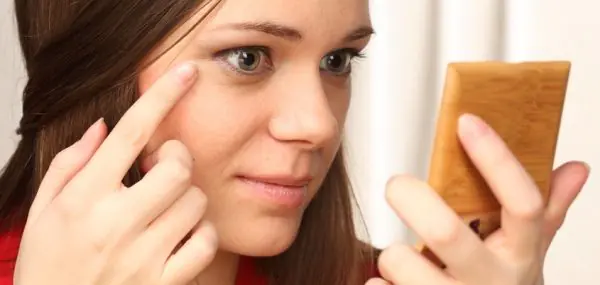
It is also recommended to carry out a course of lymphatic drainage massage in the off-season when there is a threat of vitamin deficiency, to restore skin elasticity after operations. Several sessions will be useful if you are planning to lose weight to avoid sagging skin due to sudden weight loss.
Since lymphatic drainage massage is considered a therapeutic procedure that affects the functioning of vital organs, you should carefully study the existing contraindications to its implementation.
Reasons why you should refrain from massage:
- age less than 16 years;
- the presence of wounds on the face, herpes, acne;
- problems in the functioning of the lymphatic system, inflammation of the lymph nodes in the facial area;
- blood clotting disorders;
- existing or recently suffered colds (especially ENT categories);
- signs of hypertension, diseases of the cardiovascular system;
- excessive thinness of the face (to avoid the appearance of flabby cheeks and rosacea);
- oncological diseases;
- critical days (with severe tolerance);
- pregnancy and lactation;
- chronic fatigue, long-term depression.
Important: before starting lymphatic drainage massage, it is better to consult a specialist to avoid complications resulting from unidentified contraindications.
Side effects may occur after massage sessions. In this case, you need to immediately understand the problem and fix it:
- if a rash appears, you should change the massage oil, and also better cleanse the skin after the massage;
- if your face loses a lot of weight, you should reduce the frequency of massages and reduce the force of pressure;
- if swelling appears, it means that too oily massage products are not suitable for you, and you should also carry out the procedure in the morning, not in the evening;
- the sagging did not disappear, which means that the pressure was not strong, and little massage product was used.
For those with rosacea, which is a contraindication (if there is a strong desire for lymphatic drainage), it is recommended:
- bypass the problem area;
- use a massage product that contains hesperidin;
- focus on a healthy diet, paying special attention to products with silicon;
- do not use scrubs;
- do not visit the bathhouse or sauna.
Types of lymphatic drainage facial massage
There are two ways to perform lymphatic drainage facial massage:
- hardware - carried out using special devices;
- manual - the effect on the skin is carried out with your hands.
These methods can be carried out either individually or in combination with each other. It is believed that the best effect is achieved through manual massaging, but professionals like to use various devices: special jars and metal balls to enhance the effect.
Hardware lymphatic drainage is performed using several techniques. It can only be performed by professionals in beauty salons. During the procedure, specially designed devices are used that apply microcurrent, vacuum, pressure changes, and ultrasound to the skin.
There are several methods of hardware lymphatic drainage massage:
- galvanization - carried out by exposure to a galvanic current of very weak strength. As a result, cell function is stimulated and the process of collagen production is activated. If moisturizing and stimulating substances are introduced under the skin using electrodes, this procedure is called electroiontophoresis, as a result of which harmful substances are literally expelled from the skin pores;
- vacuum massage - accelerates the outflow of lymph by applying negative pressure. Already after the first session, a decrease in swelling is noticed;
- microcurrent lymphatic drainage - is carried out due to the impact of a weak current on muscle fibers, causing them to contract, which smoothes out deep wrinkles and also moisturizes the skin, normalizing the functioning of the sebaceous glands;
- pressotherapy - has the effect of a massage with compressed air, the supply of which is carried out by the so-called pulse wave, that is, with breaks of varying durations (from several seconds to two minutes) using a special mask. The pressure level and pulse wave are controlled by a computer, in which the exact pressure force and exposure time are adjusted. This procedure promotes active circulation of fluid and its rapid removal.
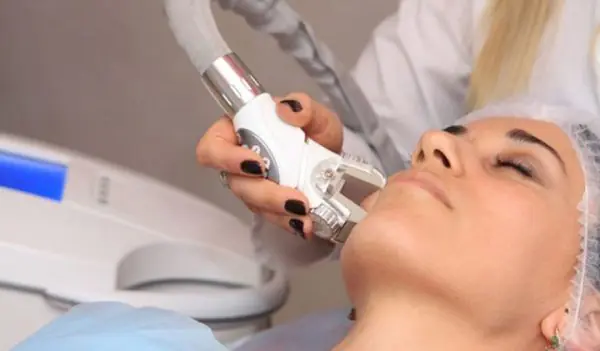
Important: the appropriate technique is selected by the doctor based on the condition of the skin and the desired goal.
Specialists who perform massage must have the appropriate qualifications and experience working with certain devices, only then the result will correspond to the expected.
Manual, or manual, lymphatic drainage massage is based on exerting force on the facial muscles, promoting their relaxation. It can be carried out with the hands of a specialist, as well as independently, but for this it is necessary to first study the correct technique for its implementation. In the first case, the effect will be stronger, since the master, due to his experience and knowledge, is able to understand whether this or that muscle is in good shape, therefore certain areas are massaged with greater intensity. However, it is not difficult to master the rules for performing such a massage, so the process of lymphatic drainage can be improved with your own hands right at home.
Video: performing manual lymphatic drainage in a beauty salon
There are two methods of performing manual lymphatic drainage facial massage:
- Japanese lymphatic drainage - involves intense impact on acupuncture points, promoting increased blood flow, thereby saturating the skin with oxygen and cleansing it of harmful substances;
- hemolymphatic drainage massage - the effect is on all layers of the epidermis, as a result of which, if performed regularly, you can get a lifting effect.
The manual technique involves pleasant relaxation. Touching problem areas allows you to feel the condition of the muscles. The estimated procedure time is 15 minutes. To achieve a visible effect, you need to carry out at least 10 regular procedures. The technology consists mainly of stroking and pressing movements along classic massage lines.
Manual lymphatic drainage is divided into 3 types, depending on the depth of impact:
- superficial - when only skin cells are processed;
- median - all layers of the dermis are affected;
- deep - special attention is paid to the facial muscles, lymphatic vessels are affected.
Many people don’t even think about how many times a day we unknowingly massage our faces. This happens while washing, drying, applying creams, and removing makeup. However, few people know that the wrong technique can not only be of no benefit, but also seriously harm the skin.

Don't forget to prepare for the procedure. After all, if you perform a massage in a hurry, on dry, unclean skin, in a bad, preoccupied mood, you will waste your time, the result will not please you, but will only aggravate the situation. To bring as much benefit as possible to the skin of the face and the body as a whole, perform the following manipulations before the massage:
- Gather your hair into a ponytail or pin up individual strands that fall in your face so that nothing gets in your way during the process.
- Wash your face with your usual cleanser and remove any remaining makeup.
- Exfoliate using a scrub.
- It would be a good idea to steam the skin to open the pores. Tilt your face over a bowl of hot water or herbal infusion, or simply apply a damp, hot towel to your face for a couple of minutes. You can also warm up your facial skin by actively rubbing it.
- Apply moisturizer to your skin. Try making your own using grape or strawberry juice and heavy cream.
Important: your hands must glide well over your face, otherwise the effect will be the opposite.
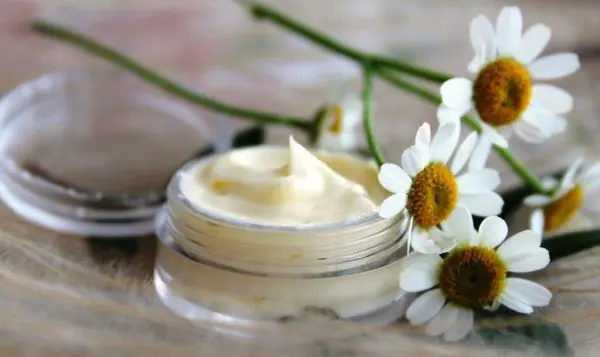
Now you are ready, and you can proceed directly to lymphatic drainage. Before the first procedure, carefully study the technique, watch videos of experienced massage therapists, and only then start:
- To begin with, we work in the forehead area. We press the pads of the fingers (index, middle, ring) of each hand to the middle of the forehead, apply pressure and make several strokes towards the temples. This exercise helps smooth out wrinkles on the forehead.
- To remove swelling from the eyes, we run our fingers along the upper eyelid from the outer edge to the inner and in the opposite direction. First above the lash line, then under the brow arch.
- Along the lower eyelid, starting from the bridge of the nose, using pressing movements, draw with the pads of your fingers to the temple. We return to the beginning along the route above the upper eyelid.
- To smooth out the nasolabial folds, we run our fingers along the line of the indentations, making gentle pressure every centimeter.
- To tone the muscles in the cheek area, massage the areas from the jaw to the eyes with the central part of the palm, making circular movements.
- To eliminate sagging cheeks, use the lower part of the back of your hand to press on the sides of the jaws and move them upward.
- Against circumlabial wrinkles, use two fingers, pressing them tightly to the skin, to outline the contour of the lips.
- To reduce a double chin, use the bottom of the back of your hand to move from the center of the chin to the temples, pressing your hands tightly to the skin.
Each exercise should be repeated 8–10 times. Try to completely relax your facial muscles. All manipulations should bring pleasure and pleasant sensations. Under no circumstances should you feel pain. Movements should be gentle, with stroking and soft pressure, directed along the massage lines from bottom to top to the nearest lymph nodes. Putting too much pressure on the skin can cause blood vessels to rupture.
It is necessary to be able to correctly complete a lymphatic drainage massage. To do this, master simple movements that can be performed after each exercise:
- press your fingers on the lymph nodes located near the ear;
- go down to the neck, alternately pressing on every centimeter of skin.
Video: technique for performing lymphatic drainage massage at home
Japanese lymphatic drainage requires strict adherence to the rules for its implementation. In order to ensure proper lymphatic drainage, it is necessary to study the locations of lymph nodes and the paths of lymph flow using a special atlas. Each massage movement has a strict direction, the degree of pressure is quite strong, but always painless.
The exercises must end with the following technique: with three fingers on both sides, press on the parotid points at the location of the lymph nodes and hold for about 2 seconds, then slowly move your fingers down to the collarbones. This key massage technique ensures the drainage of lymph from facial tissues. At the end of the procedure, make light patting movements. It is ideal to perform this massage once a week.
Japanese technique can be found under the names “Asahi” or “Dzogan”. In Japanese families, this technique was passed down from generation to generation, so the best performers are rightfully considered to be natives of the Land of the Rising Sun.

Having thoroughly studied all the nuances, you can try to do this procedure yourself:
- Forehead. The purpose of this exercise is to expel intercellular fluid accumulated under the skin. Press three fingers of both hands to the center of the forehead for 3 seconds, then with pressure move them to the temples. After this, reducing the impact, move towards the ears and behind the back.
- Skin around the eyes. Using the tips of your middle fingers, move from the outer edge of the eye to the inner one, fix the pressure near the bridge of the nose for 3 seconds. Then, increasing the pressure, move it under the eyebrow arches to the outer corner of the eye and also fix the pressure on the edge of the eye socket. Next, return to the inner corner, but along the lower eyelid, and then along the lower orbital bone to the outer edge of the eye, where you fix the pressure for 3 seconds.
- Corners of lips. Fix the middle and ring fingers in the middle of the chin, then, pressing intensely, move them around the lips and stop in the central part above the upper lip.
- Nasolabial triangle. To reduce nasolabial wrinkles, fix your middle fingers on the depressions at the wings of the nose, slightly stretching them with up and down movements. Then, adding the ring finger, move your fingers, stretching the skin towards the cheeks.
- Lips. We form the lip line using our palms. Fix their bases in the middle of the chin, moving your fingers towards your ears. With pressure, stroke the chin from the center to the ear.
- Chin. To eliminate a double chin, you should support your chin with the base of your palm and forcefully move your hand towards your earlobe along the contour of your face. Do the same on the other side.
Video: Japanese massage “Asahi”
Reviews
I live in a small town, so we don’t have anything special. Micro-tricks are the same as lymphatic drainage massage. It’s like a Skinmaster device. It’s done within 40 minutes. I feel good, but for those who have a problem not with swelling, but with dry facial skin with a network of small wrinkles, the procedure does not give them anything, I recommend it to those with swelling. Although, again, some on the forum wrote that it did not help them.
Guest
http://www.woman.ru/beauty/body/thread/4143664/
To begin with, my face was swollen from this massage, but this was simply because I did it incorrectly. I found the technique on the Internet, and there the Japanese woman pressed lightly on her face. But the point is that, on the contrary, you need to press your fingers very hard on your face. My problems are the following: circles under the eyes, chubby cheeks and a double chin (despite the fact that I am thin). I noticed the effect of the massage already in the 2nd week: namely, my double chin went away and my cheeks became thinner. But I struggled with the problem of circles under my eyes for a month with the help of this massage. And one more thing: acne appeared on my forehead and cheeks, but this defect was warned about in the description of this massage. Of course, if you do it for, say, a month, and then give it all up, all the shortcomings will come back. Therefore, it is necessary to do it every day. But it only takes 10 minutes, don't skimp on it, and you'll look great.
Nastya is evil
http://irecommend.ru/content/v-zerkale-vy-uvidite-drugogo-cheloveka-foto-litsa-do-i-posle
So I practiced this massage every day for four months and was satisfied with everything. And today the unexpected happened. Perhaps I pressed too hard under my eye, I don’t remember, I seemed to do everything as usual, but during the day a lump grew under my eye. It seems to be filled with liquid and there is redness. Girls, be very careful with this massage. I can't say anything bad about it, the problem is its incorrect application. And since you and I are not professional cosmetologists, the likelihood of making a mistake is high. One wrong move that you won't even notice - and such a bag under the eye. And who knows for how long??......I am very upset. Of course, I’m stopping Asahi massage.
Dryad
http://irecommend.ru/content/otzyv-preduprezhdenie-odno-nevernoe-dvizhenie-i-meshok-pod-glazom-foto
To improve facial skin health, even out color, and relieve swelling, you need to restore the proper functioning of the lymphatic system. To do this, you need to conduct several sessions of lymphatic drainage massage. It’s great if you have the opportunity to seek the help of professionals in a cosmetology office. But if this option does not suit you, then you can carry out such treatment procedures at home. Carefully study all the nuances of performing lymphatic drainage so as not to harm yourself even more. And don’t skip procedures, because regularity is the key to success and effective results!



